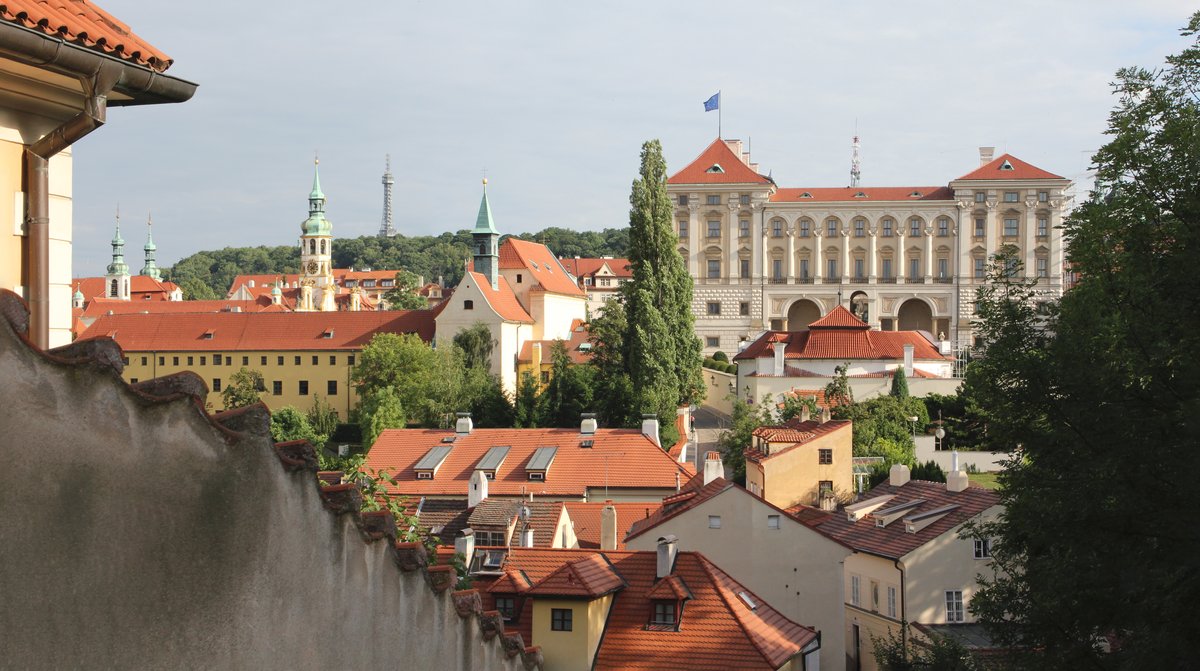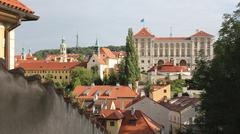
Visiting Černín Palace, Prague: Complete Guide to Tickets, Hours, and Tips
Date: 14/06/2025
Introduction: Why Visit Černín Palace?
Černín Palace (Černínský palác) is a monumental Baroque landmark in Prague’s Hradčany district, representing centuries of Czech aristocratic heritage, architectural magnificence, and political intrigue. Commissioned in the late 17th century by Count Humprecht Jan Černín of Chudenice, the palace was designed to rival imperial residences—its grand façade, stretching over 150 meters with 365 windows and 30 Corinthian half-columns, is the longest Baroque palace frontage in Prague. The palace’s history is intricately linked to the evolution of Czech statehood, diplomacy, and some of the nation’s most dramatic 20th-century episodes, including the mysterious death of Jan Masaryk in 1948.
While Černín Palace is primarily the seat of the Ministry of Foreign Affairs and not open daily to the public, it offers visitors a unique opportunity to experience its splendid Baroque gardens during special events and select periods. Its location near Prague Castle, Loreta Sanctuary, and Strahov Monastery makes it a pivotal stop for anyone exploring the heart of Prague’s historical landscape (Ministry of Foreign Affairs; Radio Prague International; Prague Guide).
This guide provides an in-depth look at Černín Palace’s origins, architectural and garden design, historical significance, practical visitor information, and tips for making the most of your visit.
Table of Contents
- Introduction
- Origins and Construction
- Černín Family and Early Use
- Decline, War, and Repurposing
- Restoration and Modern Role
- The Jan Masaryk Mystery
- Visiting Černín Palace: Hours, Tickets & Tips
- Garden Design and Features
- Accessibility and Getting There
- Nearby Attractions
- Frequently Asked Questions (FAQ)
- Summary and Visitor Recommendations
- Official Sources
Origins and Construction of Černín Palace
Commissioned in 1669 by Count Humprecht Jan Černín—an influential diplomat—the palace was envisioned as a symbol of noble prestige and a rival to the Habsburg court. Swiss-Italian architect Francesco Caratti led the design, blending Italianate Baroque grandeur with Central European traditions. The palace’s construction continued for decades, with contributions from architects like G.B. Alliprandi, F.M. Kaňka, and later Anselmo Lurago, who added porches and a balcony in 1740.
The interiors, adorned by sculptor Matyáš Bernard Braun and painter Václav Vavřinec Reiner, reflect the highest levels of Baroque artistry. The palace’s monumental façade, with its impressive rustication and imposing columns, was explicitly designed to awe visitors and dignitaries (Pragitecture; Old Town Explorer).
The Černín Family and Early Use
The Černín family, among Bohemia’s oldest noble lineages, invested heavily in the palace’s decoration, filling it with art, tapestries, and treasures from across Europe. It became a center for aristocratic gatherings—most notably hosting the gala for Emperor Leopold II’s coronation. However, the palace’s maintenance strained family finances, leading to their relocation to Vienna and eventual sale of the property.
Decline, War, and Repurposing
Černín Palace’s fortunes waned in the 18th and 19th centuries. It was damaged by French and Prussian forces, then repurposed as a poorhouse, military barracks, and warehouse. The Černín family sold the property to the state in 1851, ending its era as a noble residence (Radio Prague International).
Restoration and Modern Role
After the foundation of Czechoslovakia in 1918, the palace was restored under architect Pavel Janák, who sensitively inserted modern administrative wings without disturbing the Baroque character. Since 1934, Černín Palace has housed the Ministry of Foreign Affairs, serving as a venue for major diplomatic events—including the 1991 signing dissolving the Warsaw Pact and, more recently, high-profile summits (Prague Forum).
The Jan Masaryk Mystery
On March 10, 1948, Jan Masaryk—Foreign Minister and son of Czechoslovakia’s first president—was found dead in the palace courtyard. Officially ruled a suicide, many believe he was murdered during the Communist coup, making Černín Palace a symbol of Czech democracy’s struggles. The site remains a focus of ongoing historical investigation (Radio Prague International).
Visiting Černín Palace: Hours, Tickets & Practical Tips
General Visitor Information
- Palace Interiors: Not regularly open to the public due to government use.
- Special Openings: Public guided tours and limited interior access during European Heritage Days (mid-September), national holidays, and select cultural events. Advance booking is essential.
- Tickets: Tours are typically free but require advance registration. Check the Ministry of Foreign Affairs website for announcements.
- Garden Access: The Černín Garden is open May–September, typically 10:00–17:00. Entry is free, but hours may vary—check official sources for updates.
- Photography: Permitted in the garden and of the palace exterior; restricted inside during tours.
- Security: Expect screenings on special tour days. Large bags and prohibited items are not allowed.
- Dress Code: No formal requirement, but respectful attire is recommended during events (Lonely Planet).
Garden Design and Features
The Černín Garden (Černínská zahrada) was conceived as a Baroque extension of the palace, designed by Francesco Caratti and later enhanced by Domenico Rossi (cascading pools) and Anselmo Lurago (summer house). The two main terraces are linked by staircases, centered around ornamental pools and decorated with balustrades, urns, and a prominent Hercules statue by Ignác František Platzer.
After decades of neglect and 19th-century modification, a major restoration in 1929 revived the garden’s original terraced structure and features. In 1990, a border stone from the Czech-Bavarian frontier was added to symbolize the opening of borders after Communism (prague.cz).
Accessibility and Getting There
- Accessibility: The historic structure and garden terraces include steps and uneven surfaces; wheelchair access is limited—contact the Ministry in advance for assistance.
- Location: Loretánské náměstí 5, 118 00 Praha 1-Hradčany. Accessible by tram (lines 22, 23—Pohořelec stop) or on foot from Prague Castle (PragueWise).
- Facilities: No public restrooms in the garden; nearest amenities are at Prague Castle or nearby cafés.
Nearby Attractions
Černín Palace’s central location puts many of Prague’s top historical sites within easy reach:
- Prague Castle: The city’s most iconic castle complex.
- Loreta Sanctuary: A baroque pilgrimage site opposite the palace.
- Strahov Monastery: Famous for its library and panoramic city views.
- Nový Svět Quarter: Picturesque lanes with historic charm.
Plan your visit to include these sites for a comprehensive cultural experience (Couple Travel the World).
Frequently Asked Questions (FAQ)
Q: Is Černín Palace open to the public?
A: The interiors are generally closed, but guided tours are available during special events. The gardens are open to the public May–September.
Q: Are tickets required?
A: Garden access is free; tours inside the palace require advance, free registration.
Q: Is the site wheelchair accessible?
A: Limited access due to historic architecture; contact the Ministry for arrangements.
Q: How do I get to Černín Palace?
A: By tram to Pohořelec or on foot from Prague Castle.
Q: What should I see nearby?
A: Loreta, Prague Castle, Strahov Monastery, and Nový Svět.
Summary and Visitor Recommendations
Černín Palace stands as a testament to the ambition of the Czech aristocracy, the turbulence of European history, and the ongoing story of Czech diplomacy. While the palace’s interiors are mostly reserved for official use, its gardens invite the public to enjoy a rare blend of Baroque artistry and tranquil green space. For the best experience, time your visit with garden opening days or special tour events, and explore the surrounding Hradčany district for a deep dive into Prague’s historical and cultural heart.
Advance planning is recommended—consult official Ministry announcements for tour opportunities and check accessibility if needed. Enhance your visit with local audio guides or apps for richer context.
Official Sources and Further Reading
- Ministry of Foreign Affairs
- Prague Guide
- PragueWise
- Radio Prague International
- Old Town Explorer
- Pragitecture
- Couple Travel the World
- Prague Forum
- Lonely Planet
Download the Audiala app for guided tours, travel tips, and up-to-date information on Prague’s historical sites. Stay connected through our social media channels for news on exclusive tours and cultural events.























































































































































































